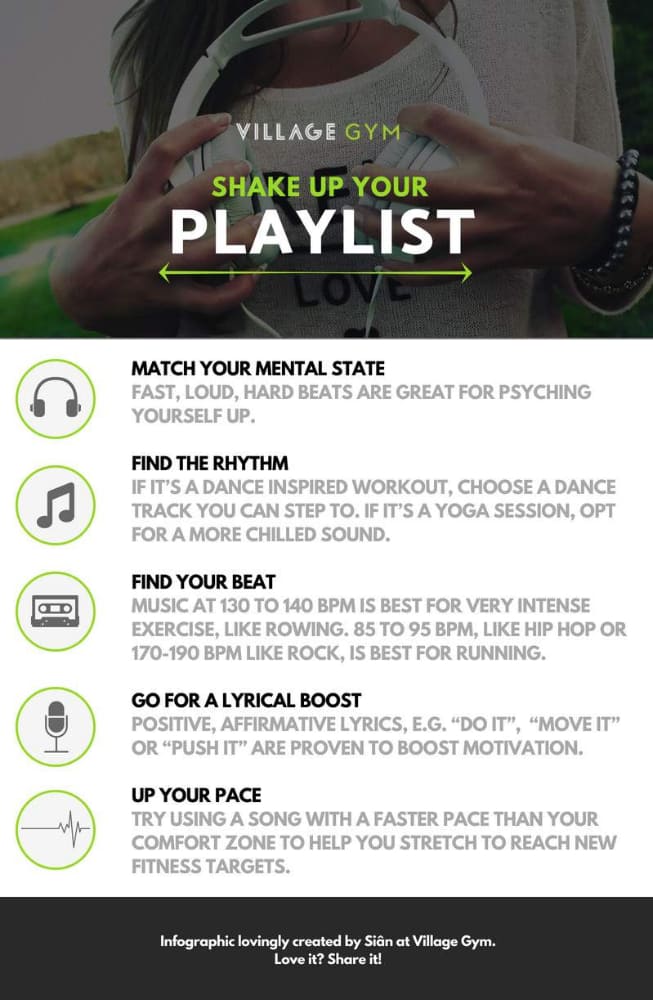You may not have heard of ‘kama muta’ – but chances are you’ve experienced it during your favourite workout.
That mix of positive emotions, physical exhilaration and community experience that the music provides also has its own name. Coined to describe the sudden feeling of ‘oneness’ we experience when we hear a song that speaks to us, ‘kama muta’ is Sanskrit for ‘moved by love’. Researchers know it is felt by people all over the world, regardless of race, geography, background or age. Music literally crosses borders to bring us together – so it’s no surprise it’s the soul of every good workout.
We all have that playlist that provides the perfect soundtrack to a great workout. From old school classics, to the latest dance beats, our favourite sounds can take our fitness regime from humdrum… to high performance. In fact, exercise to music can actually make us workout more efficiently, and for longer.
Research shows that elements of music, from the lyrics to the beat, can affect performance by switching on our positive mindset (in the same way that your favourite songs make you feel good). Music can also distract us from discomfort. This is why many top athletes enjoy a spot of music to psych themselves up before competing.
Studies also show that athletes can associate a certain song with the optimum state of mind, helping them to power through and perform better thanks to a more motivated mindset.
Brain imaging allows us to see what happens when we hear music we enjoy. Researchers have used portable electroencephalogram (EEG) monitoring technology to measure three types of brainwaves during exercise. This lets them compare the brain’s electrical feedback while exercising outdoors to music, a podcast, or no soundtrack at all.
They found music rearranges the brain’s electrical frequency, causing a slight reduction in focus but enhancing enjoyment 28% more than silence and 13% more than a podcast.
Dr Karageorghis said that fitness lovers fall into two camps, with either an “associative” or “dissociative” attentional style. Gym fanatics and elite athletes who frequently monitor their performance during exercise might find music too distracting. Dissociators, on the other hand, rely on music to take their mind off the pain!
It’s likely that music affects our hypothalamus (the region of the brain governing hormone release and emotions) and our brainstem (which controls heart rate, blood pressure, body temperature, and muscle tension). Researchers have found that dance music with faster beats and stimulating sounds increases how much cortisol, noradrenaline and growth hormone we make – all helping us to feel more awake, pumped and ready for action. By contrast, calming music, with softer sounds and a slower beat, has been shown to reduce cortisol and noradrenaline levels, helping us feel more relaxed.
Alongside the individual feelings we experience there’s also the influence from shared experience (such as when we’re working out together) – something we call ‘the group effect’. We now know that when we move together in rhythm we become more aware and compassionate toward each other. We perceive more similarities between ourselves and others in the room and because of this we’re happier sharing our personal space.
So how do you make your music work for you?

- Choose music that goes hand-in-hand with the mental state you want to achieve. For example, fast, loud, hard beats are great for psyching yourself up.
- Match the speed of the music and the rhythm with the movement. If it’s a dance inspired workout, choose a dance track you can step to. If it’s a yoga session, opt for a more chilled sound.
- Skip any music that changes dramatically half way through, it can get pretty confusing if you’ve just found your rhythm.
- As a general rule, music at 130 to 140 bpm is best for very intense exercise, like rowing. 85 to 95 bpm, like hip hop or 170-190 bpm like rock, is best for running.
- Positive, affirmative lyrics, e.g. “do it”, “move it” or “push it” are proven to boost motivation.
- Try using a song with a faster pace than your usual comfort zone to help you stretch to reach new fitness targets.
What’s your most motivational fitness class song? Let us know on our Facebook page.
Thanks to Les Mills for the insight! Originally shared on lesmills.com.




